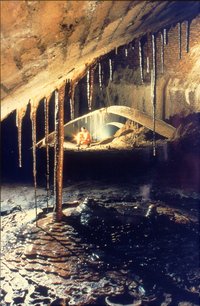Research Topic: The Untergrund
Berlin is built on sand…
The year 1237 is still considered the official year the city was founded, as this was the first time Cölln, the small twin city on the River Spree, was mentioned. The first documented mention of Berlin followed in 1244. However, in 2008, archaeologists found an oak beam which probably dates back to 1183. This would make Berlin 54 years older than previously thought. The excavation took place in Petriplatz, one of the oldest areas in Berlin. At the end of the 12th century, Berlin developed from the two small merchant settlements of Berlin and Cölln, located on both sides of the Spree, into today's district of Mitte. And here we must ask ourselves an important question about the founding of Berlin: how was this "Brandenburg sandbox", which was traditionally quite a poor area, able to develop from the two rather insignificant small settlements and become what is today - by far - the largest German metropolis? It is even more astonishing when one considers that this process can only be explained if one understands how the sandy, marshy ground was developed for construction and later for the urban supply systems, such as the sewage system, the gas, water and power lines or public transport.
The digging does not want to end.
Quote from Otto Schmelzer, 1896, extract from the book “Dunkle Welten – Bunker, Tunnel und Gewölbe unter Berlin” (“Dark Worlds – Bunkers, Tunnels and Vaults under Berlin”)
“When the winter storms give way to the spring breeze, the digging invariably begins in Berlin. Summer in the German capital would be a good deal more bearable if this much vilified digging, which the Berliners vent their anger over all year long, could be avoided. But it is a necessary evil in the metropolis. The prim and proper citizen is overcome with goose bumps when, in the morning, he steps out of his bed chamber into the front room to check the weather and must now see that, in the night by torchlight or in the early morning hours, that dreaded road work is being tackled, which threatens to curtail his comfort for a very long time. If his street is covered with asphalt, the dark fug from the 'Schmorkessel' (cauldron) drifts to the sky, blackens the house, assaults the nostrils and lays heavily on the lungs; if it is paved with stones, the dust seeps mercilessly through every crack in the windows, and the monotonous, pulsating pounding of the rushing rammer constantly rattles the eardrum and the ever-delicate nerves of the city-dweller. In addition to the discomfort on the street itself with the passage of pedestrians and carts, the damage to business, which is often connected with it especially for the shopkeepers - one cannot hold it against the Berliner if he wants all of the digging to go jump in a lake.”
instagram takipçi satın al - instagram takipçi satın al mobil ödeme - takipçi satın al
bahis siteleri - deneme bonusu - casino siteleri
bahis siteleri - kaçak bahis - canlı bahis


